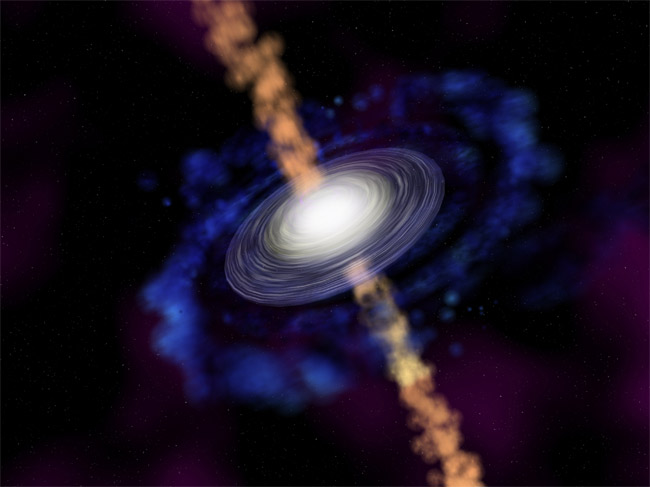Jets Spiral in 'Reverse Whirlpool' from Star

Astronomershave observed for the first time a jet of matter spiraling outward from aninfant star, as if a lengthy strand of curly pasta.
Theenormous jet, which shoots out in two directions, is rocketing material awayfrom the so-called protostar and into interstellar space at more than"supersonic speeds." From end to end, the bipolar jet extends 16,000 astronomicalunits (AU), where 1 AU is the average distance between the Earth and sun.
Called Herbig-Haro(HH) 211, the protostar is located about 1,000 light-years away in theconstellation Perseus. Scientists have estimated HH 211 started gatheringstellar material about 20,000 or so years ago.
"It'slike an infant compared to the sun," said astronomer Qizhou Zhang of theHarvard-Smithsonian Center for Astrophysics in Cambridge, Mass. "Ultimatelythis object we observed will grow into a star like the sun, but right now it'sonly 6 percent of the mass of the sun."
The finding,detailed in the Dec. 1 issue of the Astrophysical Journal, confirms akey step of starformation, one that astronomers have suspected since the 1980s.
Stellarbirth
Stars arethought to form at the center of rotating disks of hydrogen gas and dust. Overtime, protostarspack on material from spinning disks, meanwhile getting hotter and hotter,until they begin nuclear fusion. This hydrogen-burning process keeps full-blownstars aglow.
Get the Space.com Newsletter
Breaking space news, the latest updates on rocket launches, skywatching events and more!
However,there's a stellar glitch of sorts. Similar to dizzying rides that rotate soswiftly riders stick to the outer walls, as a disk rotates faster and faster,the swirling matter sticks to the disk's outer edge. The gas can't fall inwardtoward the staruntil it sheds excess spin power called angular momentum.
"Ithas to get rid of the spin energy otherwise the matter will just keep swirlingaround in this disk around the star without actually going into the star,"Zhang told SPACE.com.
Reversewhirlpool
Theorysuggests nascent stars could shed excess angular momentum in the form of gasspiraling outward around shooting jets. Zhang and his colleagues glimpsed suchspiraling gas using the Submillimeter Array (SMA), which consists of eight radiotelescopes located atop Mauna Kea in Hawaii.
Measurementsshowed matter rotating around the jet's axis in a sort of "reversewhirlpool." The results suggest the bipolar jet moves outward at a speedgreater than 200,000 mph (322,000 kph), while matter swirls around the jet'smajor axis at more than 3,000 mph (4,828 kph).
"HH211 essentially is a ?reverse whirlpool,'" Zhang explained. "Insteadof water swirling around and down into a drain, we see gas swirling around andoutward."
- Most Amazing Space Discoveries of 2007
- Video: Searching for Superstars
- Top 10 Star Mysteries
Join our Space Forums to keep talking space on the latest missions, night sky and more! And if you have a news tip, correction or comment, let us know at: community@space.com.










